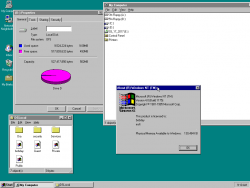Windows Cairo
From BetaArchive Wiki
 |
|
| Codename Preliminary name |
Cairo |
|---|---|
| Kernel version | 3.1, 4.0 |
| CPU architecture | x86 |
Microsoft Cairo is the codename of an unreleased software project by Microsoft, meant to bring next-generation technologies for Microsoft's NT Based Operating Systems. The project was originally announced at the 1991 PDC (Professional Developers Conference) and later demoed at the 1993 PDC.
Timeline
- 1992: Jim Allchin details a vision for a new version of Windows, code-named Cairo, which would include a revamped user interface and a new data store, called the Object File System (OFS), for storing document files, spreadsheets, multimedia files and other information. The goal is to enable searching not only by file name, but by file content. Cairo would also include a new directory service. The operating system is expected to debut in 1994.
- May 1994: Allchin tells the press that Microsoft has reassigned programmers to work on the upcoming Windows 95 desktop operating system, delaying the shipment of Cairo until late 1995.
- November 1994: Microsoft says Cairo will slip again, this time until "sometime in 1996" then-executive Vice President Mike Maples told Computerworld.
- August 1995: Microsoft ships Windows 95, which includes the revamped user interface originally slated for Cairo. Microsoft says the first test version of Cairo will debut in late 1996, pushing the release date to 1997.
- December 1995: Gates launches his "Internet initiative" to make Web technologies a top priority at Microsoft. Work on Cairo is reassessed.
- 1996: Bill Gates says Cairo is a "vision," not a product, leading many to believe the project is running into a roadblock. Gates tells Computerworld: "Cairo is a futuristic system. It's something we're working on."
- March 1996: Microsoft says work on the OFS for a future release of Windows NT has been abandoned in favor of a file system based on its Exchange Server.
- August 1996: Gates says some Cairo technologies, including indexing capabilities and a distributed version of Microsoft's Component Object Model software, will be included in Windows NT 4.0, and directory features will be part of NT 5.0. The product jockeying causes Goldman Sachs analyst Rick Sherlund to say: "I think Cairo has lost its definition."
- 1997: Rumors circulate that the OFS will debut by year's end. Gates tells PC Magazine: "The only thing of (the Cairo) vision that's not in the marketplace is the file system and directory. And so later this year that'll go into beta testing." NT 5.0 enters beta testing, but the file system is never seen.
- October 1998: Microsoft says it will rename Windows NT 5.0 to be called Windows 2000. The operating system will include Active Directory, technology originally slated for Cairo.
- February 2000: Windows 2000 debuts after several delays.
- 2001: Allchin says he has "not given up" on the OFS concept.
- January 2002: CEO Steve Ballmer says, "We want to evolve our storage system." Allchin says the OFS unified storage concept is again in development and will be a major part of Longhorn, the code name for the next version of Windows.
— Mike Ricciuti, New Windows could solve age-old format puzzle--at a price, [1]
SKUs
- Cairo Advanced Desktop was designed as the Client for Cairo servers. It would have included the core OS, new user interface, and networked storage/printer sharing.
- Cairo Advanced Server
- Cairo Development Environment
Builds
- No information available
- Existence doubtful
- Information or pictures available
- Leaked or released
- 3.1.297.1[2][3]
- PDC 1993 build - shown at the Professional Developers Conference held on December 1993[4]
- 4.0.1175.1
References
- ↑ Ricciuti, Mike (13 March 2002). New Windows could solve age-old format puzzle--at a price. CNET News.com. Archived from the original on 10 June 2004. Retrieved on 31 March 2021.
- ↑ "In a preferred embodiment, the database 102 may generally be of a type which is known in the art, such as a collection of text objects supported by Cairo Milestone 4 running under the Windows NT system version 297, available from Microsoft Corporation of Redmond, Washington, and may be accessed in conjunction with the object file system 107 of that product", Case-based organizing and querying of a database (19 January 1995 [publication date]). Retrieved on 31 March 2021.
- ↑ ReflectiaX (16 August 2018). Pieces of Cairo's History. Retrieved on 31 March 2021.
- ↑ https://ascii.jp/elem/000/000/322/322868/